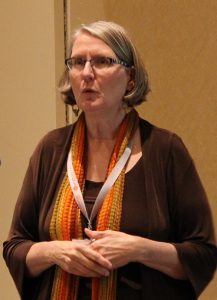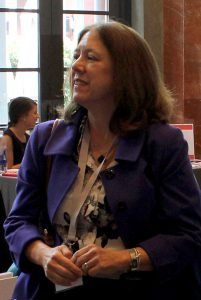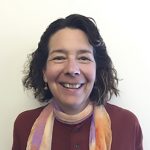What I Learned at the Women in Statistics and Data Science Conference
Donna LaLonde, ASA Director of Strategic Initiatives and Outreach
“The Women in Statistics and Data Science (WSDS) Conference is a great venue for young, female statisticians like myself to build and strengthen connections.” ~ Comment from a graduate student who attended WSDS
Tag Yourself!
Throughout the conference, we asked attendees to describe in a word or two—or 12—what WSDS means to them. Visit the ASA’s Facebook page to view all the photos, and please tag yourself!
A young colleague who was not able to attend the Women in Statistics and Data Science conference (WSDS) asked me about it, which made me reflect on my experiences. In this recap, I want to share what I learned. Of course, I want to know what you learned, so please send your comments to me or add comments below.
The keynote address was given by Donna Jean Brogan, and the plenary talks were presented by Susmita Data, Jeri Mulrow, and Bonnie Ray. Susmita Datta presented the opening plenary and, through sharing her story, highlighted the themes of the conference—knowledge, influence, and community.
During her talk, Jeri Mulrow showed a slide indicating her career path had been nonlinear, which generated laughter and applause. She went on to encourage the audience to “know where you fit.”
At the celebration banquet, Donna Brogan described her life of learning and encouraged us to do the same. And as the conference’s closing plenary, Bonnie Ray’s talk, “Questions I Should Have Asked,” provided excellent advice for making career choices.
From the different paths pursued by these talented women, I learned that a productive career is a mix of successes, challenges, compromises, and definitely a willingness to take risks.
Members of the conference’s executive committee worked tirelessly to plan the conference program and coordinate the travel awards. Throughout the conference, these women continued to focus on ensuring a positive conference experience for all participants. I learned that my talented colleagues are exceptional multi-taskers, generous with their time and energy, and committed to celebrating women in statistics and data science.
We have video (this conference was our pilot for livestreaming talks) to celebrate WSDS 2017. Visit the ASA’s
(@AmstatNews) web page on Periscope to view the talks.
“I’m always more excited than nervous to give talks because I’m so interested in how well the material I prepare will be received.” This comment was shared with me from one of the 2017 Travel Award recipients. I suspect it captures the feelings of all the presenters, regardless of their career stage.
Again this year, the more than 400 conference participants had the opportunity to attend technical and professional development presentations, panel presentations, and speed sessions. Presentations included “Statistics in the Courts” by Alicia Laura Carriquiry, “Visualization of Large-Scale Simulations for Scientific Discovery” by Joanne R. Wendelberger, “Move Out of the Comfort Zone and TextM for Crowdsourcing” by Jiayang Sun, and “Navigating Minefields to Claim the Right to Exercise Creative Thinking” by Nancy Flournoy.
A range of issues were also explored during invigorating panels, including “Call Her Madam President: A Discussion with Women Leaders in the Statistics Community,” moderated by Kim Sellers with panelists Scarlett Bellamy, Anne Lindblad, and Nalini Ravishanker, and “‘Too Young’ to Lead … but Stepping Up Anyway: Shifting the Leadership Pendulum in (Bio)Statistics and Data Science,” moderated by Emma Benn with panelists Leslie Ain McClure, Merlise A. Clyde, Dionne L. Price, and Elizabeth A. Stuart. View the complete program online.

Dalene Stangl gives her concurrent session talk, “Power Dynamics in the Classroom: The Influence of Gender and Consequences for Promotion.”

Jeri Mulrow of the Bureau of Justice Statistics answers questions after her talk: “Statistical Leadership in the Federal Government.”
In addition to the formal program, participants had the option of participating in a pre-conference short course. This year, the courses were Calibrating Your ‘GPS’ (Growth in Professionalism – Strategies), taught by Rochelle Tractenberg, and Writing R Functions for Fun and Profit, taught by Jenny Bryan. From all the amazing presentations and the informal conversations, I learned a lot!
The first WSDS hackathon for service focused on the problem of human trafficking. Planning for the hackathon began shortly after WSDS 2016, with Samantha Chiu contributing many hours to its development. Of course, the sponsorship from Microsoft, including T-shirts, was great. The teams presented their work during the closing session, and the audience affirmed that the projects were amazing.
Lucy D’Agostino McGowan, Mine Dogucu, and Jacquelyn Neal scraped the web to present a preliminary analysis of the California legislature’s efforts related to human trafficking. The team of Nada Abdalla, Jingchen Hu, Yongmei Huang, Priya Kohi, and Yun You completed a preliminary analysis of trafficking trends by country and prosecutions by year.
Building on their backgrounds in econometrics, Jessica Dutra and Fulya Ozcan completed a preliminary analysis of human trafficking as repugnant markets.
The team from NC State harnessed Twitter data to inform anti-trafficking policy. Team members Katherine Allen, Iris Bennett, Jocelyn Cui, Lili Wu, and Joyce Yu developed a website as part of their project.
Aziza Salako, competing in her first hackathon, presented her project investigating the potential connection between child homelessness and trafficking.
Everyone agreed all the entries were “winning,” so each team will designate an organization and a donation will be made in its name. I learned first attempts can exceed expectations and set a high bar for future events.













The future is brighter! Nice coverpage too. Keep up the excellent work.
Cheers,
Sastry
Thank you, Donna, for the wonderful synopsis!
Welcome!
Amstat News is the monthly membership magazine of the American Statistical Association, bringing you news and notices of the ASA, its chapters, its sections, and its members. Other departments in the magazine include announcements and news of upcoming meetings, continuing education courses, and statistics awards.
ASA HOME
Departments
Archives
ADVERTISERS
PROFESSIONAL OPPORTUNITIES
FDA
US Census Bureau
Software
STATA
QUOTABLE
“ My ASA friendships and partnerships are some of my most treasured, especially because the ASA has enabled me to work across many institutional boundaries and
with colleagues from many types of organizations.”
— Mark Daniel Ward
Editorial Staff
Managing Editor
Megan Murphy
Graphic Designers / Production Coordinators
Olivia Brown
Meg Ruyle
Communications Strategist
Val Nirala
Advertising Manager
Christina Bonner
Contributing Staff Members
Kim Gilliam